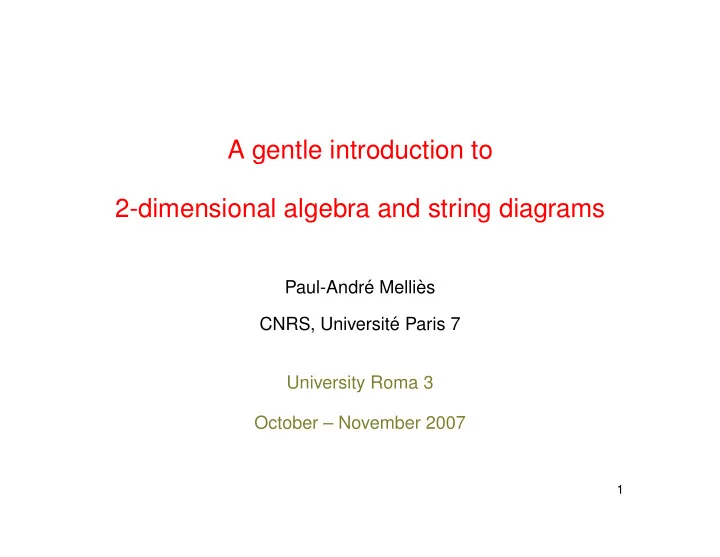

Sliding (naturality in U ) B B u V V = f f U U u A A 64
Tightening (naturality in A, B ) b b = f f a a 65
Vanishing (monoidality in U ) U U ⊗ V I V = = f f f f 66
Superposing f g = f g = f g 67
Yanking = = U U U 68
Traces = fixpoints (Hasegawa - Hyland 1997) In cartesian categories: U U ∆ Fix : �→ f U f A U A Well-behaved parametric fixpoint operator. 69
Traces = parametric fixpoints (1) U ∆ U f A 70
Traces = parametric fixpoints (2) U f f U ∆ ∆ A 71
Traces = parametric fixpoints (3) U ∆ f U U f A ∆ A 72
Traces = parametric fixpoints (4) U f U A ∆ U f ∆ A 73
Traces = parametric fixpoints (5) U f ∆ U A f A ∆ A 74
Traces = parametric fixpoints (6) U f U ∆ ∆ U U = f f ∆ A A 75
Illustration Transport of trace 76
� � Categorical semantics of linear logic (Nick Benton 1994) A symmetric monoidal adjunction L M L ⊥ M M cartesian L symmetric monoidal closed ! = L ◦ M 77
� � Braided linear logic A balanced monoidal adjunction L M L ⊥ M M cartesian L balanced monoidal closed ! = L ◦ M 78
� � Original question When does a trace in the category L lifts to a trace in the category M ? L M L ⊥ M Observation: the functor L is usually faithful . 79
Derived question Characterize when a faithful balanced functor F : C − → D between balanced categories transport a trace in D to a trace in C . 80
Characterization There exists a trace on C preserved by the functor F ⇐ ⇒ for all objects A, B, U and morphism f : A ⊗ U − → B ⊗ U there exists a morphism g : A − → B such that FA,FB ( m − 1 F ( g ) = Tr FU [ A,B ] ◦ F ( f ) ◦ m [ A,B ] ) 81
Pictorially... The last equality is depicted as follows: FB FB FU B = g f A F F FA FA 82
Proof sketch... First step: define the operator B U B ( ) tr U = U f f A,B A U A 83
which transports every morphism f to the unique morphism such that FB FB FU U = f f F F FA FA Second step: prove that tr satisfies the axioms of a trace operator. 84
Illustration: sliding (1) We want to show that B B u V V = U f f U u A A 85
Illustration: sliding (2) Because the functor F is faithful , this reduces to FB FB u V V = U f f U u F F FA FA 86
Illustration: sliding (3) FB V f U u F FA 87
Illustration: sliding (4) FB FV f U u F FA 88
Illustration: sliding (5) FB FV f U F FU u F FA 89
Illustration: sliding (6) FB FU u F FV V f F FA 90
Illustration: sliding (7) FB FU u V f F FA 91
Illustration: sliding (8) FB u V U f F FA 92
Examples • The relational model of linear logic, • Game semantics (starting from Joyal’s category of Conway games) Provides well-behaved parametric fixpoints in game semantics 93
� � Non-Example (Masahito Hasegawa) The adjunction generated by the powerset monad : L category of coalgebras Kleisli category Set Rel ⊥ M The trace of a function in Rel is not a function anymore Here, connections to Ryu Hasegawa and Nicola Gambino’s works. 94
Dualities 95
Duality A duality between X and Y is a pair of morphisms: X ⊗ Y → I I → Y ⊗ X depicted as Y X X Y 96
Duality satisfying the two equalities: Y = Y X = X In that case, one writes X ⊣ Y and says that X is left dual of Y . 97
Tortile category A balanced category C is called tortile when every object U has a left dual: U ∗ ⊣ U. 98
Tortile category (2) → C op . Property: The left duality defines a functor C − f ∗ f → V is transported to the morphism V ∗ → U ∗ Every morphism U − − depicted below: U ∗ V f U V ∗ 99
Tortile category (3) → C coop . Property: The left duality functor is strong monoidal C − Moreover, B ∗ ⊗ A ∗ ∼ ( A ⊗ B ) ∗ = 100
Recommend
More recommend